Education Services
 The Individuals with Disabilities Education Act of 2004 (IDEA ’04) and the Arizona Administrative Code (AAC) define child find requirements to ensure eligible infants, toddlers, preschoolers and school-aged children have access to early intervention or special education and related services. IDEA, Parts B and C (34 C.F.R. §§ 300 et seq.,34 C.F.R. §§ 303 et seq.) and the A.A.C. R7-2-401 (C)(D).
The Individuals with Disabilities Education Act of 2004 (IDEA ’04) and the Arizona Administrative Code (AAC) define child find requirements to ensure eligible infants, toddlers, preschoolers and school-aged children have access to early intervention or special education and related services. IDEA, Parts B and C (34 C.F.R. §§ 300 et seq.,34 C.F.R. §§ 303 et seq.) and the A.A.C. R7-2-401 (C)(D).
Child Find Activities
1. What is a Public Education Agency’s (PEA) “child find” responsibility?
PEAs are required to establish, implement and disseminate to its school-based personnel and all parents within the PEA’s boundaries of responsibility written procedures for the identification and referral of all children with disabilities age birth-21, regardless of the severity of their disability.
2. What additional child find activities are the responsibilities of a unified school district, elementary school district or union high school district?
They will identify, locate and evaluate all children with disabilities within their geographic region who are in need of special education and related services, including, children who are homeless, highly mobile, including migrant children, wards of the state, children attending private school, and children who are suspected of being a child with a disability and in need of special education, even though they are advancing from grade to grade. Children aged birth to 2 years, 10 ½ months are referred to the Arizona Early Intervention Program (AzEIP).
3. What child find activities are the responsibilities of charter schools?
For a school-aged child (K-12) the charter school in which the student is enrolled is accountable for child find activities. It is the school’s responsibility to identify and evaluate students with disabilities, including children who are suspected of being a child with a disability and in need of special education, even though they are advancing from grade to grade. For a child aged 2 years, 10 ½ months to 5 years the charter school shall refer the child to the child’s district of residence. Infants and toddlers aged birth to 2 years, 10 ½ months are referred to AzEIP.
4. Who is responsible for child find activities for school aged students who attend private schools?
The school district within whose boundaries the private school is located is responsible for child find activities.
5. Who is responsible for child find activities for the student who is home schooled?
The school district within whose boundaries the home-schooled student resides is responsible for child find activities.
6. What is the PEA’s obligation for students transferring from another PEA?
The PEA shall review enrollment data and educational performance in the prior PEA. If there is a history of special education for a student not currently eligible for special education, or poor progress, the name of the student shall be submitted to the administrator for consideration of the need for a referral for a full and individual evaluation or other services.
7. Whose responsibility is child find for students in secure care facilities?
Minor-aged students in secure care facilities are the responsibility of the secure care facility for all educational needs. Students who are the age of majority that attend an educational program in a secure facility are the responsibility of that secure care facility.
8. Does the PEA have to maintain documentation of child find activities conducted?
Yes, the PEA is required to maintain documentation of screenings, dates of entry into school/notification by parents, and dates that the screenings were completed. These need to be maintained in the student’s permanent record.
9. Are PEAs required to annually “train” all school-based staff on child find?
No, the PEA is not required to annually train school-based staff. The PEA is required to review written procedures related to child identification and referral on an annual basis with all school-based staff.
Screening
10. Who may refer a child for screening?
Anyone who has concerns about a child’s development or academic achievement may refer the student for screening i.e., parents, family members, or school staff.
11. What needs to be included in a comprehensive screening?
Screening procedures shall include vision and hearing status, and consideration of the following areas: cognitive or academic, communication, motor, social or behavioral, adaptive development. Screening does not include detailed individualized comprehensive evaluation procedures.
12. What is the timeframe for conducting screening for possible disabilities?
Screening shall be completed within 45 calendar days after entry into preschool, kindergarten, or for newly enrolled school-aged children. Screening is also required after receiving parent notification of a possible disability for children aged 3-21 years.
13. Does the PEA have to notify parents of a concern resulting from a screening?
Yes, the parents must be notified of any concern found during screening within 10 school days. Additionally, the PEA must include procedures they will utilize to follow up on the student’s needs. This could lead to a full and individual evaluation.
Resources
- Arizona Administrative Code, www.azed.gov/ess/resources/lawsRegs/7-02.pdf
- IDEA ‘04 Regulations, www.azed.gov/ess/resources/lawsRegs/06-6656IDEA04Regulations.pdf
- Sample Policies and Procedures, ADE, Exceptional Student Services, www.azed.gov/ess/policyprocedures

